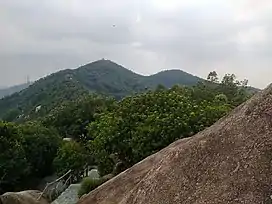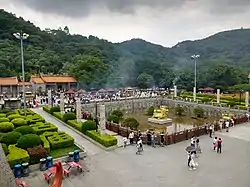| Fenghuang Mountain | |
|---|---|
| Phoenix Mountain | |
 | |
| Highest point | |
| Elevation | 376 metres (1,234 ft) |
| Coordinates | 22°40′16″N 113°50′53″E / 22.67111°N 113.84806°E |
| Naming | |
| Native name | |
| Geography | |
| Location | Bao'an District, Shenzhen, Guangdong, China |
Fenghuang Mountain (simplified Chinese: 凤凰山; traditional Chinese: 鳳凰山; pinyin: Fènghuáng Shān; lit. 'Phoenix Mountain') is a low mountain range located east of the mouth of the Pearl River, in Bao'an District, Shenzhen, Guangdong, China. The ridge forms a crescent shape, and its highest peak reaches an altitude of about 376 meters. It is protected as a forest park of Bao'an District. Partway up the western part of the mountain, at an altitude of 190 meters, there is a Buddhist temple, Fengyan Temple (凤岩古庙), which receives many worshippers on public holidays. At the foot of the mountain to the southwest is Shenzhen Bao'an International Airport as well as some of Shenzhen's main transportation arteries, National Highway 107 and the Guangshen Expressway. To the southeast is Tiegang Reservoir (铁岗水库), a source of drinking water for Bao'an District. On a 300-meter peak at the southern end of the range is a television transmission tower.[1]
Geography

Fenghuang Mountain is a mountain range that runs roughly north to south, located in the northwest of Shenzhen Special Economic Zone. It covers an area of 29.7 square kilometers and is about 40 kilometers from Shenzhen's city center (Futian District). At the south end is the only tunnel on the Guangshen Expressway: Hubei Hill Tunnel (虎背山隧道). At the north end is a plain on the east bank of the mouth of the Pearl River. The surrounding area includes the towns of Fuyong, Songgang, Shajing, and Gongming, as well as Dongguan's Chang'an Town. At the southwest foot of the range there were once fish ponds and farmland that went up to the banks of the Pearl River, but in the late 1980s, the city of Shenzhen began to fill in the fish ponds and fields and replaced them with Bao'an International Airport. South of the southern end of the range is the central urban part of Bao'an District.[2][3]
Noteworthy stones
Although Fenghuang Mountain is not a very tall mountain, it has lush vegetation and is celebrated for its remarkable stones. One natural boulder is known as the "nodding oriole" (莺石点头) as it resembles an oriole's mouth. The stone's name was recorded by the 1676 jinshi Wen Chaoling (文超灵), and the stone is inscribed with verses written by a number of famous people. In addition, to the right of Fengyan Temple are two boulders folded together like clasped hands, known as the "clasped hands stones" (合掌石). In the crack between the two boulders is an inscription: "Phoenix feathers transform into a dragon" (凤毛神化度云龙). According to legend, on the cliff there is also a trace of the last Song emperor Zhao Bing's dragon robe, and it was therefore named the "cliff of the hanging dragon robe" (龙袍挂壁).[2][4][5]
Buddhist culture and visitors

Like Wutong Mountain, Fenghuang Mountain is a major site of Buddhist culture in Shenzhen. Fengyan Temple is influential in Bao'an District and the surrounding area, with incense left burning throughout the year. Construction of the temple began in 1297 during the Southern Song Dynasty; it was built by descendants of Wen Tianxiang. Today it attracts many worshippers from other parts of the Pearl River Delta, who come to burn incense and pray to Buddha to bring good fortune to themselves and their families.[6]
In terms of visitor amenities, Fenghuang Mountain has a road that leads up to the temple, as well as many walking paths which go up to the summit. To provide parking for the huge numbers of cars driven by worshippers, the foot of the mountain has an extra-large parking lot with a capacity of 800 cars. On holidays such as Chinese New Year, Qingming Festival, Labor Day, National Day, and the Double Ninth Festival, the temple bustles with the activity of visitors who come to pray. According to Shenzhen News, in February 2011, Fenghuang Mountain received as many as 300,000 visitors on Chinese New Year's Eve and New Year's Day, making it the most popular visitor attraction in Shenzhen for that period.[7][8]
 Green parking lot
Green parking lot A boulder with an inscription
A boulder with an inscription View from the foot of the mountain
View from the foot of the mountain Road leading up the mountain
Road leading up the mountain Fengyan Temple
Fengyan Temple
References
- ↑ "深圳沿着绿道走进凤凰山". 中国广东省林业局. Archived from the original on 2011-01-09. Retrieved 2011-02-15.
- 1 2 "深圳凤凰山简介". 凤凰山森林公园. Retrieved 2011-02-15.
- ↑ "深快速发展的深圳机场". 中国民用航空局. Archived from the original on 2015-04-05. Retrieved 2011-02-16.
- ↑ "深圳凤凰山-凤凰奇石介绍". 深圳宝安人网. Retrieved 2011-02-15.
- ↑ "秋高氣爽 登深圳鳳凰山". orientaldaily.on.cc. Retrieved 3 October 2021.
- ↑ "深圳宝安凤凰山森林公园介绍". 宝安农业信息网. Retrieved 2011-02-15.
- ↑ "50万人春节平安畅游宝安福永凤凰山". 深圳新闻网. Retrieved 2021-10-03.
- ↑ "深圳宝安凤凰山森林公园周末开园 将免费开放". LVWAWA旅游网. Archived from the original on 2011-03-24. Retrieved 2011-02-15.

.svg.png.webp)